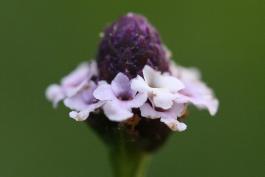Media

Scientific Name
Lippia lanceolata (formerly Phyla lanceolata)
Family
Verbenaceae (vervains)
Description
Perennial with low, trailing or ascending stems that can root at the nodes, often forming large colonies. Flowers in small, dense, spherical or cylindrical clusters, becoming more elongated with time, on long stalks arising from upper leaf axils. Individual flowers white or light pink; each with a single bract at its base, the bracts often purplish. The “irregular” (lipped) character of each flower is not immediately apparent in this species. Blooms May–September. Leaves opposite, spaced apart, elliptical to lanceolate, toothed.
Size
Trailing stems grow to about 18 inches in length.
Where To Find

Statewide.
Habitat and Conservation
Occurs in mud and gravel margins of streams, sloughs, lakes, ditches, low meadows, and other moist, wet, or muddy areas.
Human Connections
Wetlands and their many plants are a primary natural defense against floods. They function like a sponge to hold and then slowly release water, protecting other areas from flood devastation. Since the Great Flood of 1993, land managers have been restoring more wetlands.
Ecosystem Connections
Waterfowl eat the seeds. The roots of this and other profuse plants help hold the soil, preventing erosion along the waterways and other wet places where they colonize. Northern fog fruit is the primary food plant of the phaon crescent, one of the brushfooted butterflies.
Title
Media Gallery
Image

Credit
Chris Evans, Illinois Wildlife Action Plan, Bugwood.org
Right to Use
Image

Credit
Chris Evans, Illinois Wildlife Action Plan, Bugwood.org
Right to Use
Image

Image

Title
Similar Species
About Wildflowers, Grasses and Other Nonwoody Plants in Missouri
A very simple way of thinking about the green world is to divide the vascular plants into two groups: woody and nonwoody (or herbaceous). But this is an artificial division; many plant families include some species that are woody and some that are not. The diversity of nonwoody vascular plants is staggering! Think of all the ferns, grasses, sedges, lilies, peas, sunflowers, nightshades, milkweeds, mustards, mints, and mallows — weeds and wildflowers — and many more!





















